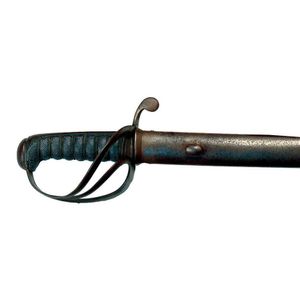German Naval Officer's Sword from World War I
You must be a subscriber, and be logged in to view price and dealer details.
Subscribe Now to view actual auction price for this item
When you subscribe, you have the option of setting the currency in which to display prices to $Au, $US, $NZ or Stg.
- Ivory - Ivory is a hard white material that comes from the tusks of elephants, mammoth, walrus and boar, or from the teeth of hippopotamus and whales. The ivory from the African elephant is the most prized source of ivory. Although the mammoth is extinct, tusks are still being unearthed in Russia and offered for sale.
Ivory has been used since the earliest times as a material for sculpture of small items, both in Europe and the east, principally China and Japan.
In Asia ivory has been carved for netsuke, seals, okimono, card cases, fan supports, animals and other figures and even as carved tusks.
In the last 200 years in Europe ivory has been used to carve figures, for elaborate tankards, snuff boxes, cane handles, embroidery and sewing accessories, in jewellery and as inlay on furniture. Its more practical uses include being used for billiard balls, buttons, and a veneers on the top of piano keys.
The use and trade of elephant ivory have become controversial because they have contributed to Due to the decline in elephant populations because of the trade in ivory, the Asian elephant was placed on Appendix One of the Convention on International Trade in Endangered Species (CITES), in 1975, and in January 1990, the African elephant was similarly listed. Under Appendix One, international trade in Asian or African elephant ivory between member countries is forbidden. Unlike trade in elephant tusks, trade in mammoth tusks is legal.
Since the invention of plastics, there have been many attempts to create an artificial ivory
This item has been included into following indexes:
Visually similar items

A Victorian 1845-1854 Pattern Infantry Officer's sword, wire bound fish skin grip, the gilt brass guard with VR cipher and hinged side section, the engraved blade showing some pitting, the steel scabbard with double captured ring hangers. Length 96 cm

An Infantry Officer's sword, wire bound raised fish skin grip, hooked quillon, engraved steel blade, ebonised steel scabbard with single hanger.

A rare British 1821 Artillery Officer's short sword, for sitting on a gun carriage, the steel hilt with three bar guard, fish skin grip with silver wire binding, engraved blade with slight curve and spear point, steel scabbard. Length 76 cm

A 19th century British Naval sword, 1827 Pattern, lion head pommel, ray skin wire bound grip, the gilt brass guard with naval insignia, folding guard section, the engraved blade with maker's details, partially worn, the brass scabbard with double captured
